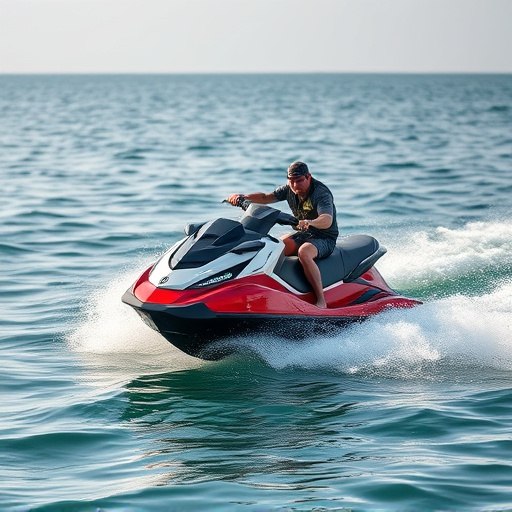Boats rely on batteries for power, making understanding different types (lead-acid, gel cell, lithium) crucial for efficient navigation. Charging methods vary from shore power and renewable energy sources to generators, ensuring optimal battery health during voyages. Regular maintenance, including terminal cleaning and temperature monitoring, extends battery lifespan. Safe practices involve professional installation, regular inspections, and desulfation to prevent damage and ensure reliable boat operation.
“Unleash the power within your vessel! This comprehensive guide navigates the art of charging boat batteries while onboard, empowering boaters with essential knowledge. From understanding battery basics—including types and charging requirements—to exploring alternative methods like solar and wind power, we cover it all. Learn the ins and outs of shore power connections for efficient charging and discover safety measures to ensure optimal battery health on extended trips. Get ready to set sail with peace of mind!”
- Understanding Boat Battery Basics: Types and Charging Needs
- Accessing Power: Identifying Onboard Charging Sources
- The Art of Shore Power Connections for Efficient Charging
- Exploring Alternative Charging Methods for Boaters
- Maintaining Optimal Battery Health During Extended Trips
- Safety Measures and Troubleshooting Tips for Boat Battery Charging
Understanding Boat Battery Basics: Types and Charging Needs

Boats, much like cars, rely on batteries for their electrical systems. Understanding the basics of boat batteries is crucial for efficient navigation and ensuring your boat’s reliability. These batteries come in various types, each with distinct characteristics and charging requirements. The most common are lead-acid batteries, known for their affordability and versatility, but they’re heavier and require regular maintenance. Gel cell and lithium batteries offer lighter alternatives, the latter being more expensive but incredibly powerful and efficient.
Knowing your boat battery type is essential as it dictates the charging method. Lead-acid batteries typically use a simple 12V or 24V charging system, while gel cells might require specific chargers designed for their sensitive nature. Lithium batteries often have smart chargers that monitor voltage, current, and temperature to prevent overcharging, ensuring longer lifespan and optimal performance.
Accessing Power: Identifying Onboard Charging Sources

Onboard boats, accessing power for charging boat batteries can be as simple or complex as the vessel’s design and amenities allow. Identified sources include dedicated battery chargers plugged into shore power during docking, solar panels that harness the sun’s energy, or wind turbines capturing passing breezes. For sailboats without these options, generators powered by engine operation become the primary means of charging batteries while underway.
Understanding how to access and utilize these diverse charging methods is essential for ensuring your boat battery remains optimally charged, especially during extended periods at sea where access to external power sources may be limited.
The Art of Shore Power Connections for Efficient Charging

In the world of boating, efficient battery charging is paramount for a smooth and enjoyable journey. One of the key aspects to master is the art of shore power connections. When moored at a dock or marina, connecting your boat to an external power source allows you to charge your essential boat batteries while taking advantage of the amenities offered by these facilities.
The process involves utilizing the shore power outlet, typically located on the dock or marina’s infrastructure, and making secure electrical connections to your vessel. This seamless integration ensures a consistent and reliable power supply for charging your boat batteries efficiently. By understanding how to navigate these connections, boaters can optimize their battery charging routines, extending the lifespan of their crucial energy sources and ensuring they’re always ready for action when venturing out on the water.
Exploring Alternative Charging Methods for Boaters

Boaters today have a growing array of options when it comes to charging their boat batteries, beyond the traditional methods of shore power or engine-driven chargers. Exploring alternative charging methods not only offers convenience and flexibility but also contributes to fuel efficiency and a reduced environmental impact. One innovative approach is the use of solar power, where specialized panels can harness the sun’s energy to recharge batteries while at sea. This method is particularly beneficial for those who spend extended periods on the water, as it provides a sustainable and clean energy source.
Another game-changer in boat battery charging are portable chargers and power banks designed specifically for marine use. These devices are lightweight, compact, and robust enough to withstand the rigors of boating while offering quick and efficient charging solutions. Whether you’re sailing, fishing, or exploring remote islands, these portable options ensure your essential electronics stay powered up without relying on available shore connections or engine operation.
Maintaining Optimal Battery Health During Extended Trips

Maintaining optimal battery health during extended trips is crucial for ensuring your boat’s reliability and performance. Regularly checking and maintaining your boat batteries is essential, especially when cruising for long periods. One key practice is to avoid fully discharging the batteries; deep discharge can significantly reduce their lifespan. Instead, keep a steady charge level by utilizing onboard charging systems or shore power whenever possible.
Additionally, monitoring temperature extremes is vital. Boat batteries perform best within moderate temperature ranges. Extreme heat can accelerate corrosion and damage internal components, while cold temperatures can lower voltage output. Regularly inspect battery terminals for any signs of corrosion and clean them to ensure optimal conductivity. Keeping batteries well-maintained will not only extend their lifespan but also guarantee consistent performance during your voyages.
Safety Measures and Troubleshooting Tips for Boat Battery Charging

When charging your boat batteries, safety should always be a top priority. Always ensure that the charging system is properly installed and maintained by professionals to prevent any accidents. Use high-quality cables and connectors to avoid short circuits or overheating. Keep an eye on the battery during the charging process; if you notice any unusual smells, sounds, or leaks, immediately disconnect the charger and inspect the battery. Regularly check battery terminals for corrosion and clean them as needed to ensure optimal conductivity.
Troubleshooting common issues can help prevent further damage. If your boat battery won’t charge, first verify that the charger is functioning correctly by testing it with a known good battery. Check connections for any loose or damaged wires. Inspect the alternator and charging system for any signs of wear or malfunction. In some cases, a desulfation process may be required to restore the battery’s performance; this can involve specialized equipment and should only be attempted if you’re familiar with the procedure.
Charging your boat batteries while onboard is a crucial aspect of responsible boater maintenance. By understanding the basics of different battery types, accessing various charging sources, and employing efficient methods like shore power connections, you can ensure optimal battery health for extended trips. Additionally, exploring alternative charging techniques and adhering to safety measures will help prevent common troubleshooting issues, keeping your boat’s electrical system running smoothly. Armed with these insights, you’re well-equipped to navigate the world of boat battery care.
